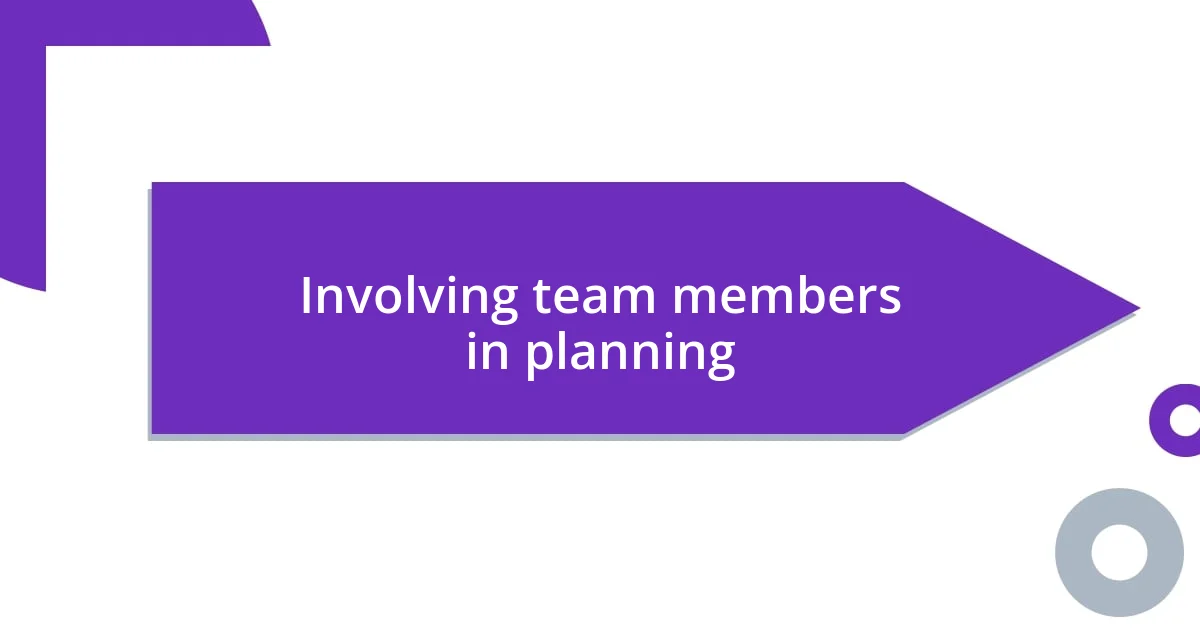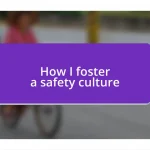Key takeaways:
- Involving team members in the planning of safety protocols fosters a sense of ownership and collaboration, transforming rules into a shared commitment to safety.
- Training staff effectively through open dialogue, role-playing, and follow-ups enhances understanding and preparedness for emergency procedures.
- Continuous monitoring and improvement of safety measures, driven by team feedback and a commitment to adaptability, reinforce a proactive safety culture.

Overview of safety protocols
Safety protocols are essential guidelines designed to protect both employees and the organization. I vividly recall a time when a minor oversight almost led to a significant injury at work, which reinforced for me just how crucial these protocols can be. It’s not just about rules; it’s about fostering a culture of safety where everyone feels responsible and empowered.
Implementing new safety protocols often feels overwhelming, doesn’t it? I remember grappling with resistance during our initial roll-out, where some team members viewed the changes as burdensome rather than beneficial. However, once we involved everyone in the training process, I noticed a shift in mindset—people began to see the protocols as tools for empowerment, ensuring their well-being at work.
A well-structured safety protocol goes beyond just written procedures; it includes training sessions, regular drills, and real-time updates to adapt to new challenges. I still think about the adrenaline rush from our first fire drill after the new protocols were established—it created a camaraderie among the team that I hadn’t felt before. In moments of potential danger, it’s reassuring to know that everyone is aligned and knows exactly what to do. Isn’t it comforting to think about how preparedness can save lives?

Identifying safety risks
When it comes to identifying safety risks, my experience has shown me the importance of observation and communication. I remember a time when I was conducting a routine inspection and noticed a loose railing in a stairwell. What seemed like a minor detail could have easily led to a serious accident. I quickly gathered the team to discuss the issue, emphasizing how even small oversights can have significant consequences.
To effectively pinpoint safety risks, consider these strategies:
- Conduct regular safety audits and inspections.
- Foster open dialogue with employees about their concerns.
- Analyze past incident reports for recurring themes.
- Encourage a culture where feedback is not only welcomed but acted upon.
- Use checklists to ensure all potential hazards are covered.
Every time I engage with my colleagues about safety, I see more than just compliance; I witness an evolving mindset towards proactive safety awareness. It’s empowering to know that together, we can create a safer workplace by simply speaking up and addressing potential risks.

Involving team members in planning
Involving team members in the planning of new safety protocols is vital for creating a supportive work environment. From my own experience, when I reached out to my colleagues for their input on proposed changes, I was surprised by the depth of insights they provided. One staff member suggested alternatives that I hadn’t even considered, which not only improved our protocols but also fostered a sense of ownership among the team. Guess what? They became advocates for the new rules, feeling personally responsible for their success.
I recall a brainstorming session where we discussed potential safety scenarios that could arise in our workspace. As we shared our thoughts, the energy in the room shifted; it felt less like a meeting and more like a collaborative mission. I could feel the enthusiasm building, and suddenly the protocols weren’t just a list of rules—they became our shared commitment to each other’s safety. It’s empowering to witness how team involvement can reshape perspectives on safety.
Moreover, integrating team members in the planning phase helps to address concerns head-on and fosters an open culture around safety. A colleague, after sharing her anxiety over emergency procedures, prompted us to revise our drills so that everyone felt more comfortable. This not only eased her worries but also encouraged others to voice their concerns as well. In my experience, such inclusion strengthens trust and ensures that protocols are practical and relatable to everyone involved.
| Benefits of Involving Team Members | Personal Insights |
|---|---|
| Enhances Ownership | Encouraged team members to advocate for safety protocols after contributing to the planning. |
| Fosters Collaboration | Shared thoughts during planning transformed our protocols into a mission for collective safety. |
| Addresses Concerns | Revised drills based on team feedback created a more comfortable environment for everyone. |

Developing clear protocol guidelines
When developing clear protocol guidelines, clarity is crucial. I remember drafting our safety manual and realizing that jargon could alienate my team rather than inform them. This realization led me to simplify the language, ensuring that everyone could understand and engage with the content, regardless of their background or experience. Wouldn’t you agree that clear communication can be the difference between compliance and confusion?
I’ve also found that visual aids play a significant role in clarifying safety protocols. During a recent training session, I introduced a flowchart that outlined our emergency procedures. The moment I saw the light bulbs go on above my colleagues’ heads, I knew we were onto something. Visuals not only capture attention but also help in retaining critical information. It made me wonder—how often do we overlook the power of a simple graphic in our communication?
Finally, getting feedback on these guidelines has been transformative. After circulating the draft, I held a casual “coffee chat” where team members could share their thoughts. The responses were incredibly insightful! One team member pointed out a step that seemed intuitive to me but was confusing for newcomers. This simple discussion reminded me that protocols must evolve, reflecting the perspectives of those who actually navigate them day to day. Isn’t it fascinating how ongoing dialogue can lead us to refine and strengthen our safety practices?

Training staff on new protocols
Training staff on new protocols is where the rubber really meets the road. Reflecting on my experience, I remember the first training session we conducted. I was nervous, worried that the protocols might seem daunting. But when I encouraged everyone to ask questions and share their thoughts, it transformed into an open dialogue. The moment a quiet team member voiced her uncertainty about a specific procedure was enlightening. It made me realize that training isn’t just about delivering information; it’s about creating a space where everyone feels safe to learn and express themselves.
Another memorable training experience involved role-playing the emergency procedures we had just revised. I can still recall the excitement in the air as team members took on different roles, acting out scenarios that could happen in real life. We laughed and joked, yet the seriousness of the subject didn’t get lost. It struck me just how effective experiential learning can be; it’s one thing to hear about a protocol, and quite another to practice it in a realistic setting. Don’t you think that hands-on training can enhance confidence, making team members feel more prepared for actual emergencies?
Finally, I made it a point to follow up with the staff after our training sessions. During one-on-one chats, I found that people genuinely appreciated the opportunity to reflect on their learning. A team member told me how much of a difference it made to articulate his understanding of the new protocols. It turns out that simply having a supportive follow-up can significantly reinforce what they’ve learned. Isn’t it curious how a little extra conversation can help solidify knowledge? The more connected and understood team members feel, the more likely they are to embrace and embody these new safety protocols.

Monitoring protocol effectiveness
Monitoring the effectiveness of new safety protocols is an ongoing journey, not a destination. I remember one particular incident where we implemented a new reporting system to track compliance. Initially, my expectation was that adherence would soar. However, after a month, the numbers told a different story. It was a tough moment, realizing that intentions don’t always translate into actions. Hasn’t anyone else experienced that bittersweet awakening when reality doesn’t meet expectations?
As we dove deeper into the data, we started connecting with team members to gather qualitative feedback. I was surprised to discover that some found the new system cumbersome, even overwhelming. This sparked an idea to simplify the user interface, and after making the adjustments, I watched as the compliance numbers gradually improved. It was a relief, a reminder that listening to the actual users of a protocol can be just as important as initial training. When was the last time you adjusted a procedure based on real-time feedback?
Ultimately, I’ve realized that success in monitoring isn’t simply about tracking numbers; it’s about fostering a continuous improvement mindset. After introducing regular check-in meetings, I noticed more team members actively engaged in discussions about protocol efficacy. Someone even brought up an instance where a minor change made a major difference in their workflow. Encouraging this type of dialogue reinforces a culture where everyone feels responsible for safety. Don’t you think that establishing an ongoing conversation can actually strengthen our safety net?

Continuous improvement of safety measures
Continuous improvement of safety measures requires a commitment to evolving our practices. I remember attending a safety seminar where the speaker emphasized the importance of staying adaptive. The discussion sparked an idea: why not encourage our team to regularly propose safety enhancements? It was fascinating to see that when I opened the floor to suggestions, team members felt empowered to share their insights. Have you ever noticed how valuing input can lead to more innovative solutions?
Another time, I set up a quarterly review to assess not just compliance numbers but also the team’s feelings about the protocols. I was surprised when one member candidly shared how stressful the safety checks had been for her. Listening to her, I realized that our systems needed a human touch, prioritizing emotional well-being alongside safety. Isn’t it eye-opening how our perceptions can offer profound clues toward improvement?
Additionally, I introduced a rewards program to highlight teams who proactively shared safety insights. One of the first recipients was new to our organization, and their excitement about being recognized for their contributions was infectious. This small act of acknowledgment not only boosted morale but also created a snowball effect where others began to participate more actively. It makes me wonder: how often do we celebrate those who champion safety measures diligently?














